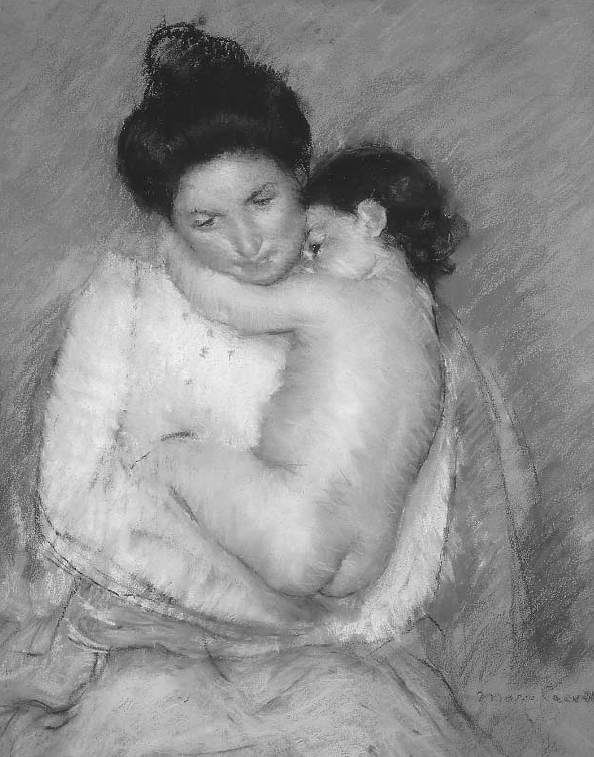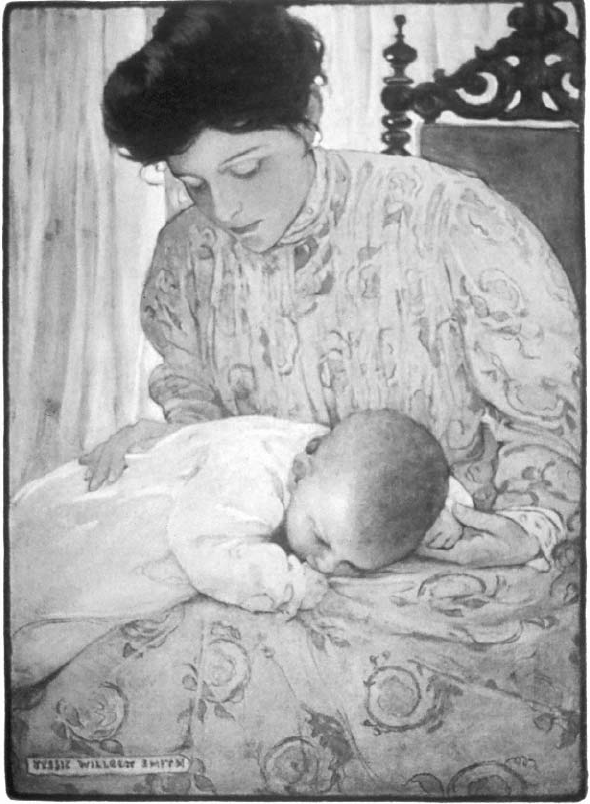ONE WAY
I first considered Cassatt's mother-child pictures in a 1992 book on Berthe Morisot's images of women (which repeated what I had said in a 1988 doctoral dissertation on Morisot). The key sentence emphasized that “the difference between Cassatt's images of maternity and other modern Madonnas is that they do offer women…[a]…possibility of visual pleasure.”[5] It is the key sentence not only because it deals with pleasure but also because it distinguishes Cassatt's pictures from all other representations of the same subject. I was using Cassatt to get from countless contemporary pictures of mothers and children to Morisot's unique treatment of that subject. Cassatt was a term-inbetween: a transition from the many to the one. I was factoring in Cassatt's artistic singularity only in order to move from pictures not remarkable because of their style to Morisot's singularity. The subject matter of all the pictures I was discussing had already been dealt with as a subject before I got to Cassatt. My monographic purpose had pushed me to define Cassatt's mother-child pictures in terms of their style.
Cassatt's style turns a conventional subject into erotic form. Unlike any of her contemporaries, Cassatt made the experience of tiny children's bodies a visceral pleasure, both for the mothers represented within her pictures and for us, the viewers of the pictures (Figure 11). By representing touch for our sight, Cassatt engages us in the joys of infant flesh.

11. Mary Cassatt, Mother and Child, ca. 1900, pastel
More than other pictures of the same subject—by Morisot, say, or by the great illustrator Jessie Willcox Smith (Figure 12)—Cassatt's pictures join the forms of mother and child. The integrity of the individual body, which we could also call its isolation, is replaced by a formal fiction of merged bodies. In virtually all of Cassatt's pictures, neither the mother's body nor the child's has its own boundary, its own space. Instead, the figures of mother and child share a border. Mimetically, we

12. Jessie Willcox Smith, First the Infant in Its Mother's Arms, 1908, pen and ink drawing
Cassatt's pictures are filled with embraces. Everything extraneous to the physical contact between mothers' and children's bodies has been eliminated. Mother and child virtually never gaze toward anyone or anything except each other, so they are engaged only in their mutual absorption. Form, too, pulls away from any outside world, swelling inward. Setting, objects, and actions are incidental, absent, subordinated, or formal versions of enclosure, echoing the containment of the child's form.[6] Replete with the substance of flesh, Cassatt's pictures are organized both two- and three-dimensionally around axes of touch. Bodies caress, kiss, fondle, hug, and stroke. Limbs and fingers, throats and cheeks, feet, hands, and lips turn toward each other, their forms gathering. Color, line, and illusions of space embrace to represent mothers and children.
We enjoy Cassatt's children because their mothers enjoy them. Of course the mothers and children are enjoying each other within the pictures. The pleasure is mutual, yet not quite reciprocal. It is always the children who wear little or no clothing, never the mothers. Even by the decorous standards of Cassatt's time, her women are covered and concealed. Had she wanted to, Cassatt could have undressed her adult female figures, licensed, like other artists, by the intimate domesticity of her subject. Moreover, the figures of the mothers are never shown beyond where they are in contact with their children. It is quite rare for the mother's entire body to be seen, and when it is, as for instance in The Bath (Chicago Art Institute), in which a mother bends forward to wash her child's foot, Cassatt has found some trick to reconcile adult and child body lengths. Much more often, the image ends at the mother's lap. Cassatt's choices declare whose bodies are the erotic objects: whose bodies are at once subjects and objects. If we were looking at pictures of naked adult women and clothed adult men, however interlaced, we would be quick to understand the implications of being clothed or unclothed. Nudity is being presented to us, the viewers. The
By enjoying their children's bodies so nakedly, Cassatt's mothers urge us to do the same, vicariously and visually. Identifying with the mother offers the most rewards. We could also identify with the babies, but we would not be getting the sight of bodies from that position, and sight is what pictures provide best. It is surprising, confusing perhaps, to see infant rather than adult bodies. It should be surprising. Cassatt is the only nineteenth-century artist I have encountered who gives us such access to the pleasures a mother feels in her child's body.
Why can I say that we are identifying with a mother's pleasure rather than a woman's? An iconography of maternity inculcated by centuries of Madonna and Child images is the easy answer. Another answer, equally important, is the issue of the child's gender. In some of Cassatt's pictures, the sex of the child is identifiable. But more often, it is not. When it is, it is about as often female as it is male (breaking with Madonna and Child precedent). In Cassatt's pictures, I would argue, sex is not an issue because the child is a generic child, not a gendered boy or girl.[7] The experience conveyed is therefore not so much the pleasure of one person in the sex of another as pleasure in a child because it is a child. Historically, that kind of pleasure has been ascribed to mothers—though hypothetically it could be experienced by anyone. It is a pleasure born of the intimate routine daily care that an infant body requires merely to survive, let alone to thrive—a pleasure that Cassatt cunningly winnows out from the shit, piss, vomit, screams, feedings, laundry, tedium, and other grim realities that actually go along with infant care. The pleasure taken could therefore be called erotic or sexual, but only with the caveat that sexuality must be understood more broadly than usual.
Cassatt's brilliant compositions can be seen in any reproduction. When her works are actually seen, however, medium and color assert their primacy. Cassatt has always been known as the impressionist who most conservatively retained illusions of bodily integrity. While other impressionists were accused of scattering the body in calligraphic excess or rotting the body with putrid color, Cassatt was praised even by cautious critics for the fresh wholesomeness of her figures. So Cassatt's use of oil or pastel in her mother-child pictures is unexpected. True, an
The degree of pleasure Cassatt provides is given through the plenitude and self-sufficiency of form. Although the subject of the mother-child pictures was guaranteed by social convention to be satisfying, the coherence and the autonomy of her style make her pictures passionate rather than sentimental. Just as fantasy is an escape from reality, Cassatt's maternal pleasure is form's escape from subject matter. The passion is in what formally exceeds the subject. Call it ecstasy, call it bliss. Psychoanalysis, prodded by the subject of the pictures, would name the ecstasy a regression to the prelinguistic, the pre-Oedipal. The great French poststructuralist critic Julia Kristeva could see the effulgence of form slipping out from under language in Bellini's Renaissance Madonnas, but not in Cassatt's mother-child pictures.[8] Was Cassatt too clumsily American, too suspiciously feminist, or simply too powerful to bear? The pious would call the ecstasy grace, a state of being in which communion releases the individual from its limits. A mother might simply call it love.